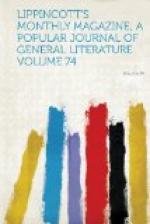“And now,” said Bhima Gandharva next day, “while you are thinking upon temples, and wondering if the Hindus have all been fools, you should complete your collection of mental materials by adding to the sight you have had of a Hindu temple proper, and to the description you have had of Jain temples proper, a sight of those marvelous subterranean works of the Buddhists proper which remain to us. We might select our examples of these either at Ellora or at Ajunta (which are on the mainland a short distance to the north-east of Bombay), the latter of which contains the most complete series of purely Buddhistic caves known in the country; or, indeed, we could find Buddhistic caves just yonder on Salsette. But let us go and see Karli at once: it is the largest shaitya (or cave-temple) in India.”
Accordingly, we took railway at Bombay, sped along the isle, over the bridge to the island of Salsette, along Salsette to Tannah, then over the bridge which connects Salsette with the mainland, across the narrow head of Bombay harbor, and so on to the station at Khandalla, about halfway between Bombay and Poonah, where we disembarked. The caves of Karli are situated but a few miles from Khandalla, and in a short time we were standing in front of a talus at the foot of a sloping hill whose summit was probably five to six hundred feet high. A flight of steps cut in the hillside led up to a ledge running out from an escarpment which was something above sixty feet high before giving off into the slope of the mountain. From the narrow and picturesque valley a flight of steps cut in the hillside led up to the platform. We could not see the facade of the shaitya on account of the concealing boscage of trees. On ascending the steps, however, and passing a small square Brahmanic chapel, where we paid a trifling fee to the priests who reside there for the purpose of protecting the place, the entire front of the excavation revealed itself, and with every moment of gazing grew in strangeness and solemn mystery.
The shaitya is hewn in the solid rock of the mountain. Just to the left of the entrance stands a heavy pillar (Silasthamba) completely detached from the temple, with a capital upon whose top stand four lions back to back. On this pillar is an inscription in Pali, which has been deciphered, and which is now considered to fix the date of the excavation conclusively at not later than the second century before the Christian era. The eye took in at first only the vague confusion of windows and pillars cut in the rock. It is supposed that originally a music-gallery stood here in front, consisting of a balcony supported out from the two octagonal pillars, and probably roofed or having a second balcony above. But the woodwork is now gone. One soon felt one’s attention becoming concentrated, however, upon a great arched window cut in the form of a horseshoe, through which one could look down what was very much like the nave




